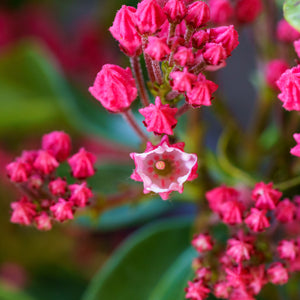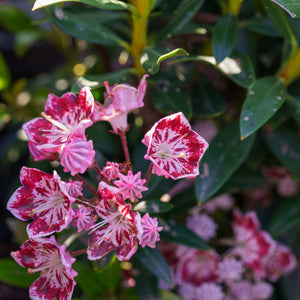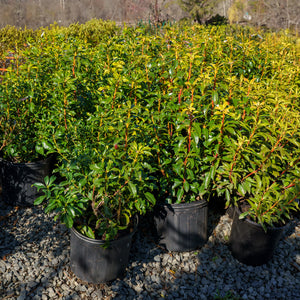The Mountain Laurel Guide
Mountain laurel (Kalmia latifolia) is a stunning broadleaf evergreen shrub native to the eastern United States, prized for its intricate flowers and year-round foliage. A staple in woodland and shade gardens, mountain laurel offers an elegant structure, glossy leaves, and clusters of delicate, star-shaped blooms in late spring. Its adaptability to poor soils and resistance to browsing deer make it a valued choice for difficult sites where beauty and toughness are both required.
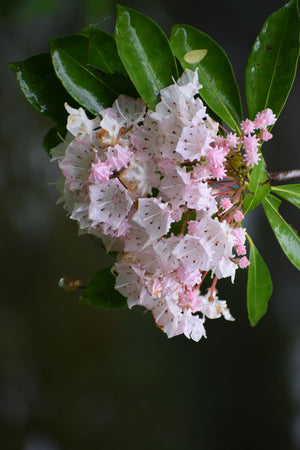
About
Kalmia latifolia is a member of the heath family (Ericaceae), closely related to rhododendrons and blueberries. It thrives in acidic, well-drained soils, particularly in wooded or mountainous areas where it forms dense, shrubby thickets. Its natural form ranges from 3 to 15 feet tall and wide, depending on growing conditions and variety.
The flowers are one of the most unique in the garden, forming tight clusters of five-lobed, crimped blooms in shades of white, pink, and red. These blossoms are often intricately marked and bloom from late May into June, attracting pollinators and gardeners alike.
Numerous cultivars expand the range of flower colors and forms. Popular selections include:
- ‘Olympic Fire’ – Vivid red buds open to deep pink flowers with a white center.
- ‘Minuet’ – A compact grower with pink flowers and a burgundy band.
- ‘Bull’s Eye’ – White flowers with bold red centers.
- ‘Carousel’ – Notable for its dramatic red-purple bands.
- ‘Elf’ – Dwarf habit ideal for foundation planting.
Mountain laurel is often used in native, woodland, and naturalistic garden settings. It thrives in conditions that mirror its natural habitat—cool, acidic, and well-drained—with dappled sunlight or partial shade.

PLANTING
Successful establishment of mountain laurel depends on replicating the well-drained, acidic conditions of its native range.
USDA Hardiness Zones: Best suited to Zones 4–8. Avoid planting in areas with extreme heat or alkaline soils.
Soil: Requires acidic, well-drained soils rich in organic matter. Does poorly in compacted, alkaline, or clay-heavy soils. Amend with peat moss or pine bark to improve structure.
Sunlight: Partial shade to dappled sunlight is ideal. Morning sun with afternoon shade offers the best balance between flowering and foliage health. Too much sun can cause leaf scorch, while deep shade reduces bloom.
Watering: Maintain evenly moist soil, especially during the establishment period. Once established, mountain laurel is moderately drought-tolerant but still benefits from consistent moisture during dry spells.
Spacing: Space plants 3 to 5 feet apart for mass plantings or informal hedges. Allow air circulation between plants to reduce disease risk.
Planting Time: Early spring or fall is best. Avoid planting during summer heat or frozen winter conditions.
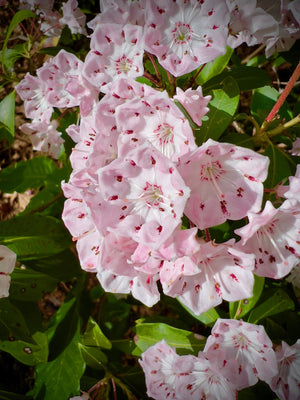
CARE
Watering: Water deeply and consistently, especially during dry periods. Avoid overwatering or allowing roots to sit in saturated soils.
Fertilizing: Use an acid-loving plant fertilizer in early spring. Avoid high-nitrogen fertilizers, which can reduce flowering.
Pruning: Prune immediately after flowering to shape the plant and remove spent blooms. Remove dead, damaged, or diseased branches anytime. Mountain laurel has a naturally dense form and requires minimal shaping.
Pests and Diseases: Watch for leaf spot, lace bugs, and scale. Ensure good airflow and avoid overhead watering to reduce fungal disease. Resistant varieties tend to be less prone to problems.
Mulching: Mulch with pine bark or pine needles to conserve moisture and maintain soil acidity. Keep mulch a few inches away from the base of the stems.

HOW TO USE
Focal Point: With its showy flowers and glossy evergreen foliage, mountain laurel makes an excellent focal point in shade gardens or woodland settings. Varieties like ‘Olympic Fire’ or ‘Star Burst’ add color and structure even in low-light areas.
Foundation Plantings: Dwarf varieties such as ‘Elf’ and ‘Minuet’ are perfect near walkways or building foundations where their compact shape and evergreen leaves provide year-round appeal.
Woodland Gardens: Plant mountain laurel alongside rhododendrons, ferns, and native azaleas for a layered, forest-inspired design. Its ability to tolerate acidic soils and partial shade makes it a natural fit.
Mass Plantings: When planted in groups, mountain laurel creates a low hedge or groundcover effect, particularly on slopes or in naturalized settings. Use cultivars with different bloom colors for variety.
Pollinator Gardens: The complex blooms attract native bees and pollinators. Combine with spring ephemerals like bleeding hearts to support early pollinators.
Erosion Control: Mountain laurel’s fibrous root system is excellent for stabilizing slopes and preventing erosion in woodland areas or shaded hillsides.
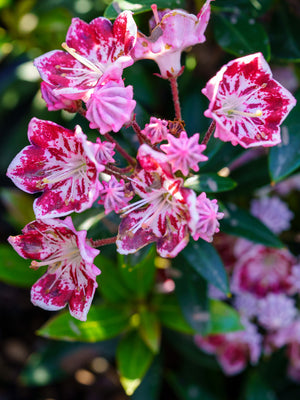
Common Questions
When does mountain laurel bloom? Most varieties bloom from late May through June, depending on the region and weather conditions.
Do deer eat mountain laurel? Mountain laurel is generally considered deer-resistant due to its toxicity. However, young plants may occasionally be sampled in harsh winters.
Do rabbits eat mountain laurel? Rabbits typically avoid mountain laurel due to its bitter taste and toxicity.
Is mountain laurel poisonous to cats and dogs? Yes, all parts of the plant are toxic if ingested by pets, including leaves and flowers.
What does mountain laurel look like? It has dense, leathery evergreen foliage and produces clusters of five-lobed, star-shaped flowers in pink, white, or red. The shrub often has twisting stems and a rounded form.
How much sun does mountain laurel need? Partial shade is best. While it can tolerate full sun in cooler climates, it thrives with filtered light and protection from harsh afternoon sun.
How fast does mountain laurel grow? It grows slowly, adding about 6–12 inches per year under ideal conditions.
How big does mountain laurel get? Depending on the variety, it can grow from 3 to 15 feet tall and wide. Dwarf selections stay under 4 feet.
Conclusion
Mountain laurel is a striking evergreen shrub that adds year-round beauty, intricate flowers, and structural value to the shade garden. Its resistance to deer, tolerance of acidic soils, and adaptability to woodland conditions make it a standout for naturalistic and formal plantings alike. Whether used as a focal point or woven into mass plantings, Kalmia latifolia remains a cherished and enduring landscape plant.
The Mountain Laurel Collection
Sold Out
Sold Out
Sold Out
Sold Out

